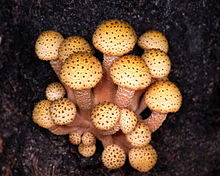| Armillaria limonea | |
|---|---|

| |
| Scientific classification | |
| Domain: | Eukaryota |
| Kingdom: | Fungi |
| Division: | Basidiomycota |
| Class: | Agaricomycetes |
| Order: | Agaricales |
| Family: | Physalacriaceae |
| Genus: | Armillaria |
| Species: | A. limonea |
| Binomial name | |
| Armillaria limonea (G.Stev.) Boesew. (2001) | |
Armillaria limonea is a species of mushroom in the family Physalacriaceae. This plant pathogen species is one of four Armillaria species that have been identified in Aotearoa New Zealand the others are A. novae-zelandiae, A. hinnulea, A. aotearoa).
In Aotearoa New Zealand the Te Reo name is harore, the English vernacular name is lemon honeycap, and the diseases caused by Armillaria species are called root rot.
Description
It was originally described as Armillariella limonea by Greta Stevenson: "Pileus 8-13 cm diam., lemon yellow, sprinkled thickly at centre and more sparsely towards the margin with dark brown, tufted scales, dry, convex at first with strongly down-rolled margin, becoming almost plane with a waved edge; flesh firm, white. Gills sinuately decurrent, moderately crowded, creamy white becoming stained pinkish fawn. Stipe 10-15 x 1-1.5 cm, light brown above substantial floccose ring, shading to brown or olive green below, velutinate, sometimes with a few tufted scales, solid, tough, slightly bulbous at base. Spores 7-8 x 5-6.5 μm, non-amyloid, moderately thick-walled; print white".
The pileus of A. limonea can sometimes be bioluminescent.
Distribution
Endemic to Aotearoa New Zealand and found in the North Island and northern South Island.
Matauranga
It is reported that Armillaria limonea has been eaten without adverse reaction although others say that it is bitter and not edible.
Hosts and disease symptoms
The Biota of New Zealand database provides an updated lists the of native and introduced plants associated with or host to A. limonea. Most records of root rot disease attributed to Armillaria species (recognised by the presence of rhizomorphs and fan-like mycelial sheets under bark) do not differentiate between A. limonea and A. novae-zealandiae.
See also
References
- Hood, I. A.; Ramsfield, T. D. (2016). "Armillaria aotearoa species nova". New Zealand Journal of Forestry Science. 46 (1): 2. Bibcode:2016NZJFS..46....2H. doi:10.1186/s40490-016-0058-y. ISSN 1179-5395.
- Buchanan, P.; Stewart, G.; Jacob, H (2017). Ngā Hekaheka o Aotearoa. Manaaki Whenua, Landcare Research. pp. 24–27. ISBN 978-1-77550-336-1.
- Ridley, G.S. "A System for the Development of English Language Names for Agarics and Boletes in New Zealand (and Australia?)" (PDF). Australasian Mycologist. 23 (1): 27–30.
- Hood, I.A. (1989). "Armillaria root disease in New Zealand Forests" (PDF). New Zealand Journal of Forestry Science. 19 (2/3): 180–197.
- Stevenson, Greta (1964). "The Agaricales of New Zealand: V". Kew Bulletin. 19 (1): 1–59. doi:10.2307/4108283. JSTOR 4108283.
- ^ Buchanan, P.; Stewart, G.; Jacob, H (2017). Ngā Hekaheka o Aotearoa. Manaaki Whenua, Landcare Research. pp. 24–27. ISBN 978-1-77550-336-1
- Ridley, G.; Horne, D. (2006). A Photographic Guide to Mushrooms and Other Fungi of New Zealand. Upstart Press. ISBN 9781990003769.
- Hall, Ian R.; New Zealand Institute for Crop & Food Research Limited, eds. (1998). Edible and poisonous mushrooms: an introduction. Christchurch, N.Z: Crop & Food Research. ISBN 978-0-478-10806-4.
- ""Biota of New Zealand. Names and Classification of Bacteria, Fungi, Land Invertebrates and Plants. Armillaria limonea (G. Stev.) Boesew. 1977"".
- Gadgil, Peter D. (2005). Fungi on trees and shrubs in New Zealand. Fungal diversity research series. Hong Kong: Fungal Diversity Press. ISBN 978-962-86765-9-0.
| Taxon identifiers | |
|---|---|
| Armillaria limonea | |
| Armillariella limonea | |